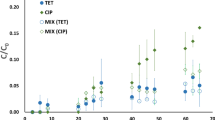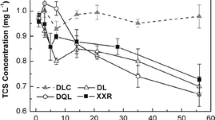Abstract
The fate and degradation of tetracycline (TC) in tropical river ecosystem was evaluated using microcosm experiments. The residual concentration of the antibiotic was monitored over a period of 90 days. Results show that multiphasic pseudo zero order kinetic model best characterize the degradation with the free form degrading at a faster rate, 6.5 and 13.6 days in the sediment and water phase. The adsorbed form degraded at a slower rate, 23.2 and 131 days in the sediment and 48.7 and 301 days in the water column. Under these environmental conditions two metabolites were observed, epi-TC and anhydro-TC which in turn also undergo complete mineralization at a faster rate than the parent compound. Furthermore the results show that the dissipation can be thermodynamically characterized in terms of the adsorption/desorption equilibrium constant and the adsorption free energy ΔGads. Adsorption ΔG values of − 3.2 kJ mol−1 and − 7.7 kJ mol−1 were obtained for the two adsorbed speciation forms in each phase, confirming that the adsorption is enthalpy driven and thermodynamically feasible. Thus the degradation of multifunctional compounds such as TC in relevant environmental conditions follow complex degradation kinetics involving speciation and adsorption/desorption hysteresis which require more information for adequate predictive estimation.




Similar content being viewed by others
Data availability
The data that support this study are available in the article and accompanying Online Supplementary Material.
References
Halling-Sørensen B, Sengeløv G, Tjørnelund J (2002) Toxicity of tetracyclines and tetracycline degradation products to environmentally relevant bacteria, including selected tetracycline-resistant bacteria. Arch Environ Contam Toxicol 42:263–271. https://doi.org/10.1007/s00244-001-0017-2
Xu W, Zhang G, Li X, Zou S, Li P, Hu Z, Li J (2007) Occurrence and elimination of antibiotics at four sewage treatment plants in the Pearl River Delta (PRD), South China. Water Res 1:4526–4534. https://doi.org/10.1016/j.watres.2007.06.023
Topal M, Topal EIA (2015) Occurrence and fate of tetracycline and degradation products in municipal biological wastewater treatment plant and transport of them in surface water. Environ Monit Assess 187:750–762. https://doi.org/10.1007/s10661-015-4978-4
He Y, Chen W, Zheng X, Wang X, Huang X (2013) Fate and removal of typical pharmaceuticals and personal care products by three different treatment processes. Sci Total Environ 447:248–254. https://doi.org/10.1016/j.scitotenv.2013.01.009
Zhou LJ, Ying GG, Liu S, Zhao JL, Yang B, Chen ZF, Lai HJ (2013) Occurrence and fate of eleven classes of antibiotics in two typical wastewater treatment plants in South China. Sci Total Environ 452–453:365–376. https://doi.org/10.1016/j.scitotenv.2013.03.010
Daghrir R, Drogui P (2013) Tetracycline antibiotics in the environment: a review. Environ Chem Lett 11:209–227. https://doi.org/10.1007/s10311-013-0404-8
Ye Z, Weinberg HS, Meyer MT (2007) Trace analysis of trimethorprim and sulfonamide, macrolide, quinolone, and tetracycline antibiotics in chlorinated drinking water using liquid chromatography electrospray tandem mass spectrometry. Anal Chem 79(3):1135–1144. https://doi.org/10.1021/ac060972a
Luo Y, Xu L, Rysz M, Wang Y, Zhang H, Alvarez PJJ (2011) Occurrence and transport of tetracycline, sulfonamide, quinolone, and macrolide antibiotics in the Haihe River Basin, China. Environ Sci Technol 45:1827–1833. https://doi.org/10.1021/es104009s
Yang JF, Ying GG, Zhao JL, Tao R, Su HC, Liu S (2011) Spatial and seasonal distribution of several antibiotics in surface waste of the Pearl Rivers, China. J Environ Sci Health B 46:272–280. https://doi.org/10.1080/03601234.2011.540540
Solliec M, Roy-Lachapelle A, Marc-Olivier G, Coté C, Généreux M, Sauvé S (2016) Fractionation and analysis of veterinary antibiotics and their related degradation products in agricultural soils and drainage waters following swine manure amendment. Sci Total Environ 543:524–535. https://doi.org/10.1016/j.scitotenv.2015.11.061
Thiang EL, Lee CW, Takada H, Seki K, Takei A, Suzuki S, Wang A, Bong CW (2021) Antibiotic residues from agriculture farms and their ecological risks in Southeast Asia: a case study from Malaysia. Ecosyst Health Sustain 7:1926337. https://doi.org/10.1080/20964129.2021.1926337
Gao P, Munir M, Xagoraraki I (2012) Correlation of tetracycline and sulfonamide antibiotics with corresponding resistance genes and resistant bacteria in a conventional municipal wastewater treatment plant. Sci Total Environ 421–422:173–183. https://doi.org/10.1016/j.scitotenv.2012.01.061
Suzuki S, Thi P, Hoa P (2012) Distribution of quinolones, sulfonamides, tetracyclines in aquatic environment and antibiotic resistance in Indonesia. Front Microbiol. https://doi.org/10.3389/fmicb.2012.00067
Suzuki S, Ogo M, Takada H, Seki K, Mizukawa K, Kadoya A, Yokokawa T, Sugimoto Y, Sato-Takabe Y, Boonla C, Amomasiri W, Sakpanyatham N (2021) Contamination of antibiotics and sul and tet (M) genes in veterinary wastewater, river and coastal sea in Thailand. Sci Total Environ 971:148423. https://doi.org/10.1016/j.scitotenv.2021.148423
Hopkins ZR, Blaney L (2014) A novel approach to modelling the reaction kinetics of tetracycline antibiotics with aqueous ozone. Sci Total Environ 468–469:337–344. https://doi.org/10.1016/j.scitotenv.2013.08.032
Saitoh T, Shibata K, Hiraide M (2014) Rapid removal and photo-degradation of tetracycline in water by surfactant assisted coagulation–sedimentation method. J Environ Chem Eng 2(I3):1852–1858. https://doi.org/10.1016/j.jece.2014.08.005
Wei R, He T, Zhang S, Zhu L, Shang B, Li Z, Wang R (2019) Occurrence of seventeen veterinary antibiotics and resistant bacteria in manure-fertilized vegetable farm soil in four provinces of China. Chemosphere 215:234–240. https://doi.org/10.1016/j.chemosphere.2018.09.152
Loftin KA, Adams CD, Meyer MT, Surampalli R (2008) Effects of ionic strength, temperature and pH on degradation of selected antibiotics. J Environ Qual 37:378–386. https://doi.org/10.2134/jeq2007.0230
Winckler C, Grafe A (2001) Use of veterinary drugs in intensive animal production. Evidence for persistence of tetracycline in pig slurry. J Soils Sediments 1:66–70. https://doi.org/10.1007/BF02987711
Verma B, Headley JV, Robarts RD (2007) Behaviour and fate of tetracycline in river and wetland waters on the Canadian Northern Great Plains. J Environ Sci Health A 42:109–117. https://doi.org/10.1080/10934520601011163
Halling-Sørensen B (2000) Algal toxicity of antibacterial agents used in intensive farming. Chemosphere 40:731–739. https://doi.org/10.1016/S0045-6535(99)00445-2
Halling-Sørensen B, Lykkeberg A, Ingerslev F, Blackwell P, Tjørnelund J (2003) Characterization of the abiotic degradation pathways of oxytetracyclines in soil interstitial water using LC–MS-MS. Chemosphere 50:1331–1342. https://doi.org/10.1016/S0045-6535(02)00766-X
Loke ML, Jespersen S, Vreeken R, Halling-Sørensen B, Tjørnelund J (2003) Determination of oxytetracycline and its degradation products by high-performance liquid chromatography tandem mass spectrometry in manure-containing anaerobic test systems. J Chromatogr B 783:11–23. https://doi.org/10.1016/S1570-0232(02)00468-3
Zaranyika MF, Dzomba P (2019) Dissipation of chlortetracycline in the aquatic environment: characterization in terms of a generalized multi-phase pseudo-zero order rate law. Int J Chem Kinet 51:1–14. https://doi.org/10.1002/kin.21311
Zirbser K, Healy R, Stahl L, Tate B, Diamond J, Burton A, Johns M, Scott J (2001) Methods for collection, storage and manipulation of sediments for chemical and toxicological analyses: technical manual. United States Environmental Protection Agency, Office of Science and Technology, Washington, DC
American Public Health Association (APHA) (2004) Method 9215B pour plate method. In: Standard methods for the examination of water and waste water, 19th edn. American Public Health Association, American Water Works Association, Water Environment Federation, Washington, DC, pp 1–36
Dzomba P, Kugara J, Zaranyika MF (2015) Extraction of tetracycline antimicrobials from river water and sediment: a comparative study of three solid phase extraction methods. Afr J Pharm Pharmacol 9(19):523–531. https://doi.org/10.5897/AJPP2015.4341
Ma Y, Gao N, Li C (2012) Degradation and pathway of tetracycline hydrochloride in aqueous solution by potassium ferrate. Environ Eng Sci 29(5):357–362. https://doi.org/10.1089/ees.2010.0475
Edwards CA (1966) Insecticide residues in soils. Residue Rev 13:83–132. https://doi.org/10.1007/978-1-4615-8407-0_4
Edwards CA (1970) Persistent pesticides in the environment. CRC Press, Cleveland
FAO/IAEA Joint Division, Agrochemicals and Food Section, International Atomic Energy Agency (1994) Appraisal of overall programme accomplishments. J Environ Sci Health B 29(1):205–226
Zaranyika MF, Dzomba P (2021) Persistence and fate of chlortetracycline in the aquatic environment under sub-tropical conditions: generation and dissipation of metabolites. J Environ Sci Health B 56(2):181–187. https://doi.org/10.1080/03601234.2020.1854009
Zaranyika MF, Dzomba P, Kugara J (2015) Degradation of oxytetracycline in the aquatic environment: a proposed steady state kinetic model that takes into account hydrolysis, photolysis, microbial degradation and adsorption by colloidal and sediment particles. Environ Chem 12:174–188. https://doi.org/10.1071/EN14116
Zaranyika MF, Dzomba P, Kugara J (2015) Speciation and persistence of doxycycline in the aquatic environment: characterization in terms of steady state kinetics. J Environ Sci Health B 50(12):908–918. https://doi.org/10.1080/03601234.2015.1067101
Gevao B, Jones KC (2002) Pesticides and persistent organic pollutants. In: Haygarth PM, Jarvis SC (eds) Agriculture, hydrology and water quality. CABI Publishing, Wallingford, pp 83–106
Ogram AV, Jessup RE, Ou LT, Rao PSC (1985) Effects of sorption on biological degradation rates of (2,4-dichlorophenoxy) acetic acid in soils. Appl Environ Microbiol 49:582–587. https://doi.org/10.1128/aem.49.3.582-587.1985
Soulas G, Lagacherie B (2001) Modelling of microbial degradation of pesticides in soils. Biol Fertil Soils 33:551–557. https://doi.org/10.1007/s003740100363
Castellan GW (1971) Physical chemistry, 2nd edn. Addison-Wesley, Reading
Gschwend PM, Wu S (1985) On the constancy of sediment–water partition coefficients of hydrophobic organic pollutants. Environ Sci Technol 19(1):90–96. https://doi.org/10.1021/es00131a011
de Atikins PW, Paula J (2006) Physical chemistry, 8th edn. Oxford University Press, Oxford, pp 791–830
Ebbing D, Gammon SD (2017) General chemistry, 11th edn. Cengage Learning Publishers, Boston, pp 271–280
Atikins PW (1982) Physical chemistry, 2nd edn. Oxford University Press, Oxford, pp 974–978
National Bureau of Standards (1976) Viscosity coefficient; corresponding states; dense liquid; mixture; modified Enskog theory; prediction; thermal conductivity coefficient. National Bureau of Standards, p 1679
Acknowledgements
This work was carried out with financial support from the Research Board of the University of Zimbabwe. The authors also acknowledge financial support provided by the African Network of Chemical Analysis of Pesticides (ANCAP) and International Program in Chemical Sciences (IPICS) to participate in ANCAP conferences and workshops. The authors acknowledge the courtesy of the Chemistry Department of Bindura University of Science Education in availing one of us (PD) the use of their laboratory facility and HPLC equipment.
Author information
Authors and Affiliations
Corresponding author
Ethics declarations
Conflict of interest
All authors declare that they have no conflict of interest or financial ties to disclose.
Additional information
Publisher's Note
Springer Nature remains neutral with regard to jurisdictional claims in published maps and institutional affiliations.
Supplementary Information
Below is the link to the electronic supplementary material.
Rights and permissions
About this article
Cite this article
Dzomba, P., Zaranyika, M.F. Degradation of tetracycline in tropical river ecosystems: generation and dissipation of metabolites; kinetic and thermodynamic parameters. Reac Kinet Mech Cat 135, 2115–2136 (2022). https://doi.org/10.1007/s11144-022-02249-z
Received:
Accepted:
Published:
Issue Date:
DOI: https://doi.org/10.1007/s11144-022-02249-z




